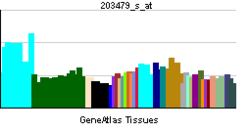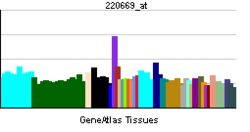- OTUD4
-
OTU domain containing 4 Identifiers Symbols OTUD4; DKFZp434I0721; DUBA6; HIN1; HSHIN1; KIAA1046 External IDs OMIM: 611744 MGI: 1098801 HomoloGene: 35370 GeneCards: OTUD4 Gene Gene Ontology Molecular function • molecular_function
• protein bindingCellular component • cellular_component Biological process • biological_process Sources: Amigo / QuickGO RNA expression pattern 


More reference expression data Orthologs Species Human Mouse Entrez 54726 73945 Ensembl ENSG00000164164 ENSMUSG00000036990 UniProt Q01804 n/a RefSeq (mRNA) NM_001102653.1 NM_001081164.1 RefSeq (protein) NP_001096123.1 NP_001074633.1 Location (UCSC) Chr 4:
146.03 – 146.1 MbChr 8:
82.16 – 82.2 MbPubMed search [1] [2] OTU domain-containing protein 4 is a protein that in humans is encoded by the OTUD4 gene.[1][2][3]
Two alternatively spliced transcript variants encoding distinct isoforms have been found for this gene. The smaller protein isoform encoded by the shorter transcript variant is found only in HIV-1 infected cells.[3]
References
- ^ Raineri I, Senn HP (Feb 1993). "HIV-1 promotor insertion revealed by selective detection of chimeric provirus-host gene transcripts". Nucleic Acids Res 20 (23): 6261–6. doi:10.1093/nar/20.23.6261. PMC 334514. PMID 1475186. http://www.pubmedcentral.nih.gov/articlerender.fcgi?tool=pmcentrez&artid=334514.
- ^ Krop I, Maguire P, Lahti-Domenici J, Lodeiro G, Richardson A, Johannsdottir HK, Nevanlinna H, Borg A, Gelman R, Barkardottir RB, Lindblom A, Polyak K (May 2003). "Lack of HIN-1 methylation in BRCA1-linked and "BRCA1-like" breast tumors". Cancer Res 63 (9): 2024–7. PMID 12727813.
- ^ a b "Entrez Gene: OTUD4 OTU domain containing 4". http://www.ncbi.nlm.nih.gov/sites/entrez?Db=gene&Cmd=ShowDetailView&TermToSearch=54726.
Further reading
- Bonaldo MF, Lennon G, Soares MB (1997). "Normalization and subtraction: two approaches to facilitate gene discovery". Genome Res. 6 (9): 791–806. doi:10.1101/gr.6.9.791. PMID 8889548.
- Kikuno R, Nagase T, Ishikawa K et al. (1999). "Prediction of the coding sequences of unidentified human genes. XIV. The complete sequences of 100 new cDNA clones from brain which code for large proteins in vitro". DNA Res. 6 (3): 197–205. doi:10.1093/dnares/6.3.197. PMID 10470851.
- Strausberg RL, Feingold EA, Grouse LH et al. (2003). "Generation and initial analysis of more than 15,000 full-length human and mouse cDNA sequences". Proc. Natl. Acad. Sci. U.S.A. 99 (26): 16899–903. doi:10.1073/pnas.242603899. PMC 139241. PMID 12477932. http://www.pubmedcentral.nih.gov/articlerender.fcgi?tool=pmcentrez&artid=139241.
- Ota T, Suzuki Y, Nishikawa T et al. (2004). "Complete sequencing and characterization of 21,243 full-length human cDNAs". Nat. Genet. 36 (1): 40–5. doi:10.1038/ng1285. PMID 14702039.
- Brill LM, Salomon AR, Ficarro SB et al. (2004). "Robust phosphoproteomic profiling of tyrosine phosphorylation sites from human T cells using immobilized metal affinity chromatography and tandem mass spectrometry". Anal. Chem. 76 (10): 2763–72. doi:10.1021/ac035352d. PMID 15144186.
- Beausoleil SA, Jedrychowski M, Schwartz D et al. (2004). "Large-scale characterization of HeLa cell nuclear phosphoproteins". Proc. Natl. Acad. Sci. U.S.A. 101 (33): 12130–5. doi:10.1073/pnas.0404720101. PMC 514446. PMID 15302935. http://www.pubmedcentral.nih.gov/articlerender.fcgi?tool=pmcentrez&artid=514446.
- Gerhard DS, Wagner L, Feingold EA et al. (2004). "The Status, Quality, and Expansion of the NIH Full-Length cDNA Project: The Mammalian Gene Collection (MGC)". Genome Res. 14 (10B): 2121–7. doi:10.1101/gr.2596504. PMC 528928. PMID 15489334. http://www.pubmedcentral.nih.gov/articlerender.fcgi?tool=pmcentrez&artid=528928.
- Rush J, Moritz A, Lee KA et al. (2005). "Immunoaffinity profiling of tyrosine phosphorylation in cancer cells". Nat. Biotechnol. 23 (1): 94–101. doi:10.1038/nbt1046. PMID 15592455.
- Kimura K, Wakamatsu A, Suzuki Y et al. (2006). "Diversification of transcriptional modulation: Large-scale identification and characterization of putative alternative promoters of human genes". Genome Res. 16 (1): 55–65. doi:10.1101/gr.4039406. PMC 1356129. PMID 16344560. http://www.pubmedcentral.nih.gov/articlerender.fcgi?tool=pmcentrez&artid=1356129.
- Beausoleil SA, Villén J, Gerber SA et al. (2006). "A probability-based approach for high-throughput protein phosphorylation analysis and site localization". Nat. Biotechnol. 24 (10): 1285–92. doi:10.1038/nbt1240. PMID 16964243.
- Olsen JV, Blagoev B, Gnad F et al. (2006). "Global, in vivo, and site-specific phosphorylation dynamics in signaling networks". Cell 127 (3): 635–48. doi:10.1016/j.cell.2006.09.026. PMID 17081983.
- Ewing RM, Chu P, Elisma F et al. (2007). "Large-scale mapping of human protein–protein interactions by mass spectrometry". Mol. Syst. Biol. 3 (1): 89. doi:10.1038/msb4100134. PMC 1847948. PMID 17353931. http://www.pubmedcentral.nih.gov/articlerender.fcgi?tool=pmcentrez&artid=1847948.
Categories:- Human proteins
- Chromosome 4 gene stubs
Wikimedia Foundation. 2010.
